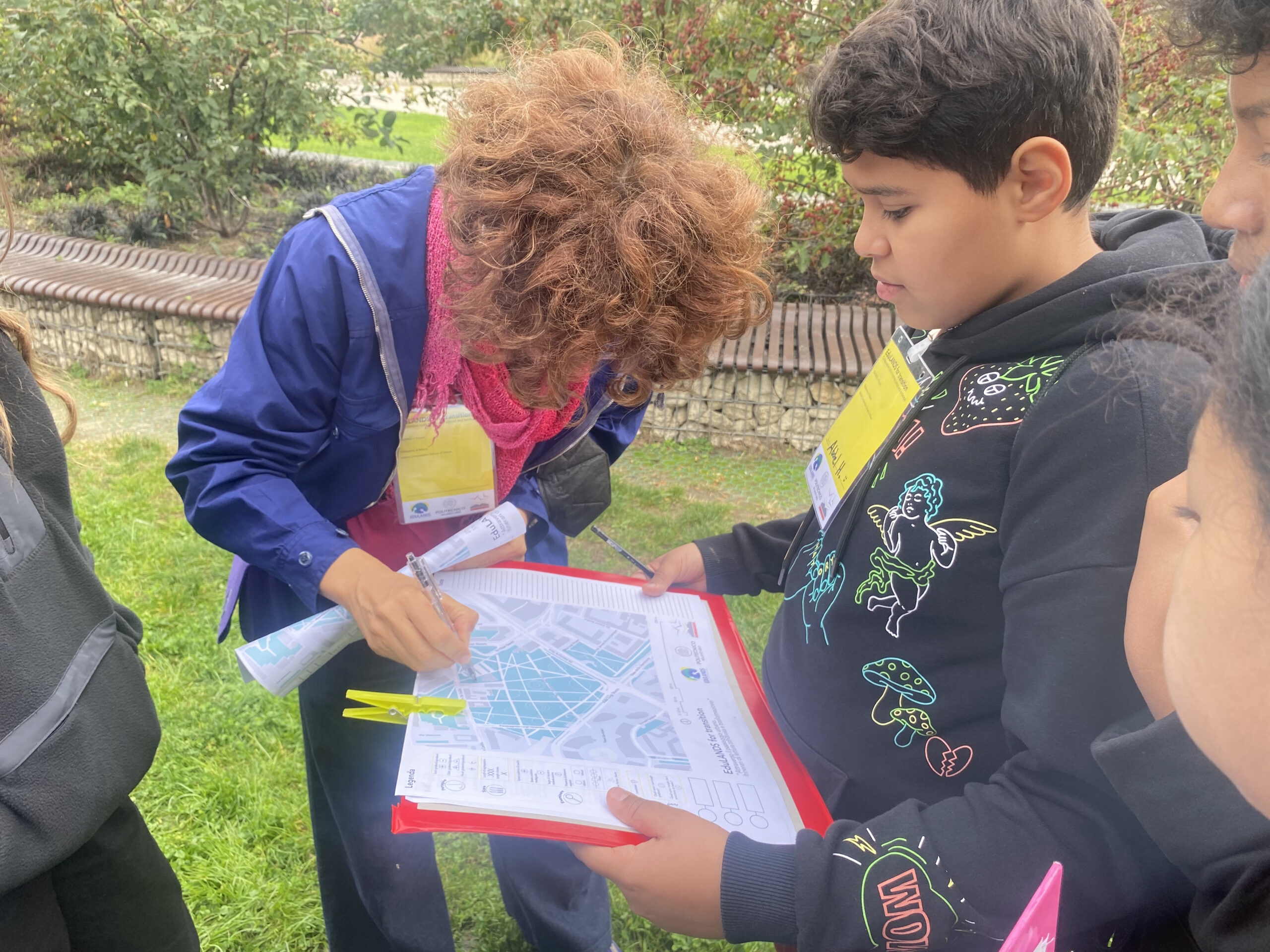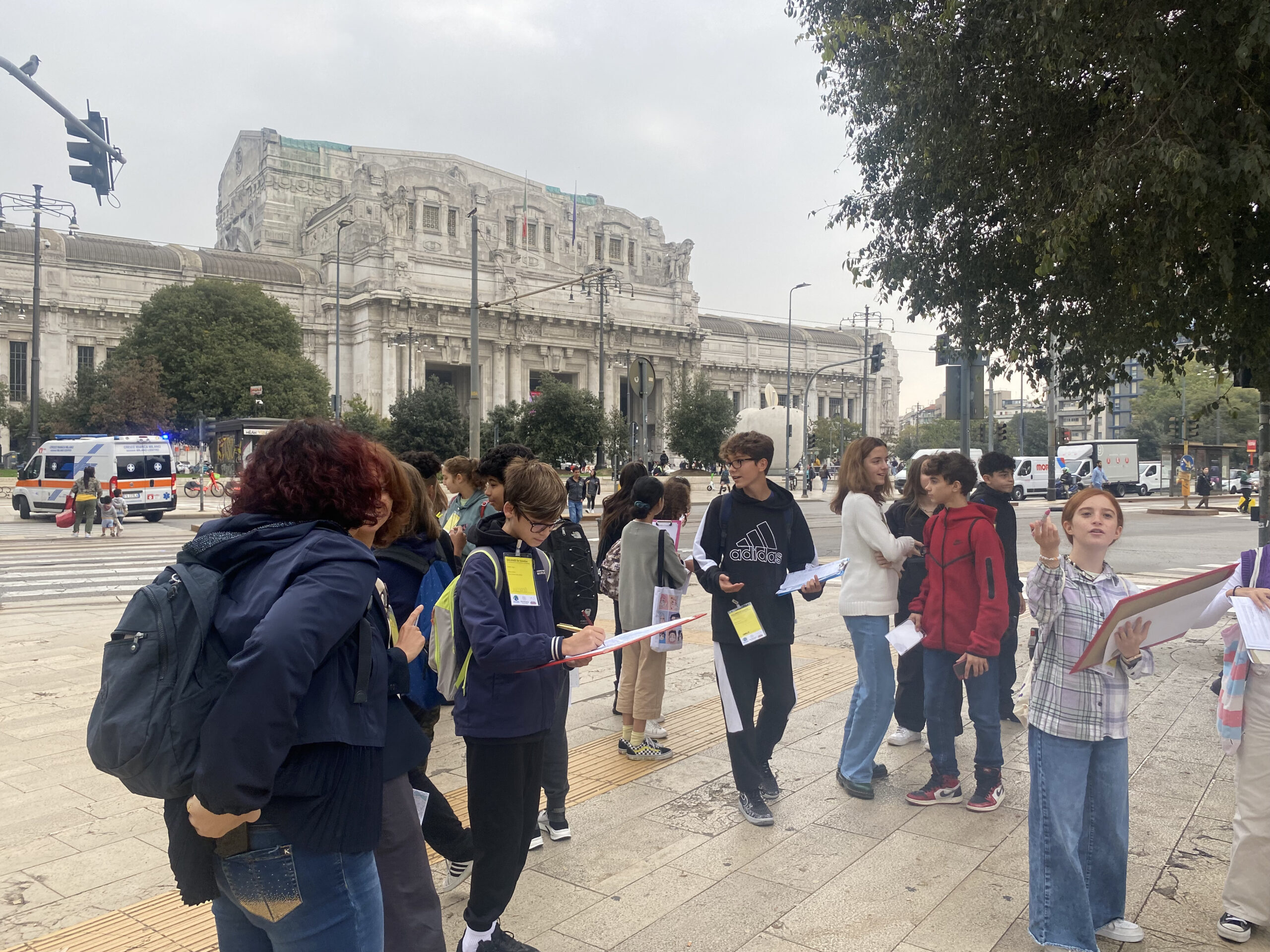
Mapping Ourselves introduced the topic to students who answered reflective questions and used small pieces of clay to shape their inner landscapes. The Mapping a Landscape phase included a pre-walk guided tour from school to the Library of Trees. Students learned to use maps/keys, gave a critical, sensorial, emotional reading of the itinerary. Following new paths on their own they interviewed people and enlarged the keys paying attention to environmental sustainability and city inclusiveness. A common and collaborative map was made opening their minds to new scenarios of possible future changes.
The learning process enabled students to understand, challenge and engage with the cultural heritage of the district surrounding their school. As responsible and active citizens, they made connections between their personal experiences and the surrounding landscape using specific tools such as topographic and sensorial maps, keys, and interviews. By the end of the experience pupils learnt to: act appropriately using sustainable competences for a sustainable future; respect and preserve the landscape by taking actions to improve the environment; be more engaged with the local community; transmit the landscape to future generations. Students also changed their starting point of views and increased their awareness about the eco-social situation building transitional images towards real sustainability.



Milan, the capital city of Lombardy, is Italy’s leading financial center well known for design and fashion. IC Galvani, attended by students from different cultural and linguistic backgrounds, is in the Stazione Centrale area considered a junction point in the city. From school it is a 15-minute walk to get to the Pirelli Tower, to the Lombardy Palace, to Gae Aulenti, to the Library of Trees, to the Vertical Forest, to Indro Montanelli Park and to Porta Venezia Public Library. As a result, the area surrounding IC Galvani, highlights an urban landscape populated by residents and tourists. Therefore, indoor schooling, the lack of green areas/outdoor spaces, traffic pollution, traffic noise, overcrowded and congested neighborhoods can be terrible knockbacks to motivation and learning. These can cause behavioral issues, isolation and affect students’ empathy and creativity. During the learning process teachers focusing on these issues, guided students to a
critical analysis of the past and current state of the urban landscape surrounding the school and gave them effective tools to propose future improvements.
Active learning methods were used to encourage students‘in-depth comprehension and critical thinking. As active investigators and problem solvers, students practiced necessary skills, struggled with complex questions, critically analyzed the landscape, and made connections between their prior knowledge and the new gathered information while acquiring a greater grasp of their local community. Teachers as facilitators guided students in their research process, encouraging critical thinking, posing thought provoking questions, and providing additional resources when needed.
The Mapping a Landscape phase followed the Mapping Ourselves ice breaking activity through which students reflected on their inner selves. Positive role interdependence was structured by assigning roles to each student in the group. Students followed paths related to the urban space around their school within a 15-minute walk. They collected data on their maps/keys and interviewed people. Then they reordered the information, wrote a common report, compared maps, and transferred on a common sensorial map all the collected data. Eventually, a metacognitive talk allowed students to make improvement proposals.
Our school, IC Luigi Galvani is a comprehensive school located in an urban area in Milan closely located to the city center and to other places of interests such as museums, monuments, historical sites, cinemas, theaters, green areas, and other facilities. The participation to the Erasmus+ Edulands for Transitions project helped teachers to exchange good practices, teaching strategies, techniques and methodologies and to implement this knowledge to the students’ benefit. More specifically, about forty middle school students from two different classes (grade 7 and 8) aged between 12 and 13 were involved in the educational experience. All the activities, carried out from September 2022 to May 2023, for a total of 40 hours, took place inside and sometimes outside the classrooms (courtyard, surrounding neighborhoods, gym) involving different school subjects such as Italian, Geography, English, Technology, Arts and Civic Education. Teachers and students worked during their morning lessons and when necessary, in the afternoon. The collaboration with the experts of the Politecnico of Milan, Professors Paola Branduini and Camilla Casonato was important as they supported and guided teachers and students during the learning process; they also prepared and taught students to use specific tools such as maps and keys.
For the development of our educational experience, we provided students with maps, keys and taught them on how to interview people. Students used video cameras and made posters representing the different phases of the activity. Clay was used to shape their inner landscapes and later the students described the object representing how they felt and in which way they were connected to it. A school trip to le Marcite which is a historical identity heritage of the Milanese agriculture, was planned too. Students improved their knowledge and reflected on the historic, cultural, and environmental value of a natural landscape close to their school. Guided by the PoliMi Professor Branduini, they carried out a practical landscape maintenance activity and from a didactic point of view students experienced a new cooperative strategy called Jigsaw.
As a rule, all the activities were assessed according to a goal process outcome-based evaluation. During the learning process, students were allowed to measure tangible, and relevant goals within a specific deadline. As part of a metacognitive process, when students revised their works, they were allowed to consider what did not go so well and fix it. In addition, the cooperative learning approach, allowed teachers to track progress of the learning process as they monitored and moved throughout the classroom, observing the students at work, giving feedback and ensuring students weren’t left behind.
Teachers observed the students, recorded their individual contribution to the activity, rated the quality of their work by using a cooperative learning observation checklist and an assessment rubric. They also provided a reflective thinking activity to prompt students reflect on what they did, how they did it, what they learned and what they still needed to do.
Finally, google satisfaction online surveys were prepared to measure students’ perception of their learning process and collect parents’ personal feedback.

